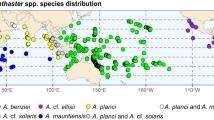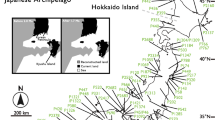Abstract
The phyllodocid polychaete Notophyllum foliosum occurs in two colour morphs in Swedish and Norwegian waters, one palish yellow to grey form with black patches that is restricted to deeper waters and often associated with reefs of the deep-water coral Lophelia pertusa, and one usually yellow-orange form with black patches and white spots that is usually encountered on more shallow bottoms. We have sampled the two forms from sympatric occurrences in Norway, and the shallow form from the Swedish west coast. Phylogenetic and haplotype analyses based on the mitochondrial cytochrome c oxidase subunit I (COI) gene and the nuclear internal transcribed spacer region (ITS1-5.8SrDNA-ITS2) unequivocally indicate that the two forms represent different species. We apply the name N. foliosum (Sars, 1835) to the ‘shallow form’, and propose N. crypticum n. sp. for the ‘deep form’. A lectotype is fixed for N. foliosum.






Similar content being viewed by others
References
Avise, J. (2000). Phylogeography. Cambridge: Cambridge University Press.
Bergström, E. (1914). Zur Systematik der Polychaetenfamilie der Phyllodociden. Zoologiska Bidrag från Uppsala, 3, 37–224.
Bickford, D., Lohman, D., Sodhi, N., Ng, P., Meier, R., Winker, K., et al. (2007). Cryptic species as a window on diversity and conservation. Trends in Ecology & Evolution, 22, 148–155.
Chen, C., Chen, C.-P., Fan, T.-Y., Yu, J.-K., & Hsieh, H.-L. (2002). Nucleotide sequences of ribosomal internal transcribed spacers and their utility in distinguishing closely related Perinereis polychaetes (Annelida; Polychaeta; Nereididiae). Marine Biotechnology, 4, 17–29.
Clement, M., Posada, D., & Crandall, K. (2000). TCS: A computer program to estimate gene genealogies. Molecular Ecology, 9, 1657–1659.
Eklöf, J., Pleijel, F., & Sundberg, P. (2007). Phylogeny of benthic Phyllodocidae (Annelida) based on morphological and molecular data. Molecular Phylogenetics and Evolution, 45, 261–271.
Farris, S. J., Albert, V. A., Källersjö, M., Lipscomb, D., & Kluge, A. G. (1996). Parsimony jackknifing outperforms neighbor-joining. Cladistics, 12, 99–124.
Folmer, O., Black, M. B., Hoeh, W. R., Lutz, R. A., & Vrijenhoek, R. C. (1994). DNA primers for amplification of mitochondrial cytochrome c oxidase subunit I from diverse metazoan invertebrates. Molecular Marine Biology and Biotechnology, 3, 294–299.
Gatesy, J., DeSalle, R., & Wheeler, W. (1993). Alignment-ambiguous nucleotide sites and the exclusion of systematic data. Molecular Phylogenetics and Evolution, 2, 152–157.
Gelman, A., Carlin, J. B., Stern, H. S., & Rubin, D. B. (1995). Bayesian data analysis. London: Chapman & Hall.
Hart, M., & Sunday, J. (2007). Things fall apart: biological species from unconnected parsimony networks. Biology Letters, 3, 509–512.
Kato, T., & Pleijel, F. (2002). A revision of Notophyllum (Phyllodocidae, Polychaeta). Journal of Natural History, 36, 1135–1178.
Klautau, M., Russo, C. A. M., Lazoski, C., Boury-Esnault, N., Thorpe, J. P., & Solé-Cava, A. M. (1999). Does cosmopolitanism result from overconservative systematics? A case study using the marine sponge Chondrilla nucula. Evolution, 53, 1414–1422.
Knowlton, N. (1993). Sibling species in the sea. Annual Review of Ecology and Systematics, 24, 189–216.
Knowlton, N. (2000). Molecular genetic analyses of species boundaries in the sea. Hydrobiologia, 420, 73–90.
Knowlton, N., & Weigt, L. (1998). New dates and new rates for divergence across the Isthmus of Panama. Proceedings of the Royal Society B: Biological Sciences, 265, 2257–2263.
Mayr, E. (1963). Animal species and evolution. Cambridge: Harvard University Press.
Mishler, B., & Theriot, E. (2000). The phylogenetic species concept (sensu Mishler and Theriot): monophyly, apomorphy, and phylogenetic species concepts. In Q. Wheeler & R. Meier (Eds.), Species concepts and phylogenetic theory. A debate (pp. 44–54). New York: Columbia University Press.
Nygren, A., Pleijel, F., & Sundberg, P. (2005). Genetic relationships between Nereimyra punctata and N. woodsholea (Hesionidae, Polychaeta). Journal of Zoological Systematics and Evolutionary Research, 43, 273–276.
Nygren, A., Eklöf, J., & Pleijel, F. (2009). Arctic-boreal sibling species of Paranaitis. Marine Biology Research, 5, 315–327.
Nylander, J. (2004). MrModeltest v2. Program distributed by the author. Uppsala: Evolutionary Biology Centre, Uppsala University.
Nylander, J., Wilgenbusch, J., Warren, D. L., & Swofford, D. L. (2007). AWTY (Are We There Yet?): a system for graphical exploration of MCMC convergence in Bayesian phylogenetics. Bioinformatics, 24, 581–583.
Ørsted, A. S. (1843). Annulatorum Danicorum Conspectus. Fasc. 1. Maricolæ. Copenhagen: Librariae Wahlianae.
Palumbi, S. R. (1994). Genetic divergence, reproductive isolation, and marine speciation. Annual Review of Ecology and Systematics, 25, 547–572.
Pleijel, F. (1993). Polychaeta. Phyllodocidae. Marine Invertebrates of Scandinavia, 8, 1–159.
Pleijel, F., & Dales, R. P. (1991). Polychaetes: British phyllodocoideans, typhloscolecoideans and tomopteroideans. Synopses of the British Fauna, New Series, 45, 1–202.
Pleijel, F., Jondelius, U., Norlinder, E., Oxelman, B., Schander, C., Sundberg, P., et al. (2008). Phylogenies without roots? A plea for the use of vouchers in molecular phylogenetic studies. Molecular Phylogenetics and Evolution, 48, 369–371.
Ronquist, F., & Huelsenbeck, J. (2003). MrBayes3: Bayesian phylogenetic inference under mixed models. Bioinformatics, 19, 1572–1574.
Saez, A., & Lozano, E. (2005). Body doubles. Nature, 433, 111.
Sars, M. (1835). Beskrivelser og iakttagelser over nogle mærkelige eller nye i havet ved den Bergenske kyst levende dyr af polypernes, acephalernes, radiaternes, annelidernes of molluskernes classer, med en kort oversigt over de hidtil af forfattaren sammesteds fundne arter of deres forekommen. Bergen: Thorstein Hallegers Forlag hos Chr. Dahl.
Schlick-Steiner, B., Seifert, B., Stauffer, C., Christian, E., Crozier, R., & Steiner, F. (2007). Without morphology, cryptic species stay in taxonomic crypsis following discovery. Trends in Ecology & Evolution, 22, 391–392.
Swofford, D. (2002). PAUP*. Phylogenetic Analysis Using Parsimony (*and other methods). Sunderland: Sinauer.
Thompson, J. D., Gibson, D. J., Plewniak, F., Jeanmougin, F., & Higgins, D. G. (1997). The ClustalX windows interface: flexible strategies for multiple sequence alignment aided by quality analysis tools. Nucleic Acids Research, 24, 4876–4882.
Wilgenbusch, J., Warren, D., & Swofford, D. (2004). A system for graphical exploration of MCMC convergence in Bayesian phylogenetic inference. http://ceb.csit.fsu.edu/awty. Accessed 22 October 2009.
Winker, K. (2005). Sibling species were first recognized by William Derham (1718). The Auk, 122, 706–707.
Acknowledgements
This paper is part of a research programme in which we analyse Scandinavian polychaete species complexes, funded by the Swedish Taxonomy Initiative (contracts 140/07 1.4 and dha 166/08 1.4 to AN), and the Adlerbert Research Foundation (to FP and AN). We wish to thank Tor Bakke, Torkild Bakken, Danny Eibye-Jacobsen, Jon Kongsrud and Christoffer Schander for help with collecting, loans, and information about museum collections, and Olaf Bininda-Emonds and two anonymous reviewers for valuable comments.
Author information
Authors and Affiliations
Corresponding author
Rights and permissions
About this article
Cite this article
Nygren, A., Eklöf, J. & Pleijel, F. Cryptic species of Notophyllum (Polychaeta: Phyllodocidae) in Scandinavian waters. Org Divers Evol 10, 193–204 (2010). https://doi.org/10.1007/s13127-010-0014-2
Received:
Accepted:
Published:
Issue Date:
DOI: https://doi.org/10.1007/s13127-010-0014-2




